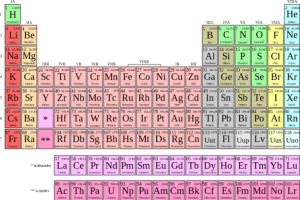Playlist
Show Playlist
Hide Playlist
Aufbau Principle – Quantum Numbers
-
Slides 02 Chemistry Basics Le Gresley.pdf
-
Download Lecture Overview
00:01 An electron on its own could adopt either spin. And this forms the basis of the Aufbau principle, and that states that orbitals of the lowest energy (i.e. those which are closest to the nucleus) are filled first. So, for example, if we look at hydrogen, which is the simplest element, we have a 1s orbital, which is shown by that straight line there, and we have a single electron in that orbital. And so therefore, our electron configuration is written simply as 1s1. That is to say, we have the first shell with the principle quantum number 1. Then we have the s orbital—okay?—so that gives us a orbital quantum number of 0. And finally, we have a single electron, which gives us that superscripted 1: the number of electrons. If we then look at other elements—so helium, for example—we can see we have two electrons. In this case, though, because there is one shell—only one shell available, the 1s shell—they have to pair. And so what you see there is one electron with a magnetic spin number of 1/2 and the other with a magnetic spin number of –1/2, both coming together, pairing. The electron configuration for helium, therefore, is 1s2, as you can see. If we look at group 1 and we look at the lithium atom, we see that we actually have, now, two principle quantum numbers. We have the first shell, the 1 shell, and we also have where n equals 2, or the second shell. This is because, as I said before, we don't have those orbitals available in the first shell. It's only when we get to shell 2 that we have both s orbitals and p orbitals available to us to populate. 01:58 So in this case, as we are moving across the periodic table, we have lithium, which possesses three electrons. The first two go into the first shell, and the third one exists as an unpaired electron in the second shell. So if we consider boron, which is in group 3 of the periodic table, with five electrons, shell 1 would be filled. Then the 2s orbital would be filled, so that the orbital with the next highest energy on the second shell will be the 2p set. Okay? So this is where we have those 3p orbitals on the second shell—second principle quantum number.
About the Lecture
The lecture Aufbau Principle – Quantum Numbers by Adam Le Gresley, PhD is from the course Chemistry: Introduction.
Included Quiz Questions
Which magnetic quantum numbers (m-l) are allowed for an orbital with quantum number (l) of 2?
- -2, -1, 0, 1, 2
- -1, 0, 1
- 0
- 1
- -3, -2, -1, 0, +1, +2, +3
Which of the following correctly describes how atomic orbitals are filled?
- Orbitals with the lowest energy are filled first.
- Orbitals with the highest energy levels are filled first.
- Orbitals that already have electrons are filled first.
- Orbital with quantum number n = 0 is filled first.
- Orbital with quantum number n = -1 is filled first.
Customer reviews
5,0 of 5 stars
| 5 Stars |
|
5 |
| 4 Stars |
|
0 |
| 3 Stars |
|
0 |
| 2 Stars |
|
0 |
| 1 Star |
|
0 |




